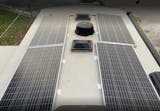Lithium-ion batteries are the most common type of rechargeable batteries in use today. They are used in a wide range of electronic devices from laptops to smartphones & electronics, and electric vehicles too. A lithium rv battery is a rechargeable battery made up of cells in which lithium ions travel from the opposing electrode to the optimistic electrode through an electrolyte during discharge and then back again during charging.
What is a lithium-ion battery
Lithium-ion batteries have been around since 1991. They are the most common type of rechargeable batteries used in portable electronics. Lithium-ion batteries are a type of rechargeable battery in which lithium ions move from one electrode to the other through an external circuit during discharge and charging. The Best Lithium Batteries provide a high power density, but their energy density is lower than that of nickel-cadmium or nickel-metal-hydride batteries.
Hydrogen ions are discharged from a negatively charged lead electrode in lead-acid batteries. The transfer is made feasible by a sulfuric acid and water solution in which both electrodes are submerged. Lead electrodes are replaced with lithium compounds, and sulphuric acid is replaced with one of many organic solvents in lithium-ion batteries.
How Lithium-ion Batteries Work
An electrolyte, cathode, separator, and two current collectors make up a battery (positive and negative). The lithium is stored in the anode and cathode. Through the separator, the electrolyte transports positively charged lithium ions from the anode to the cathode and vice versa. The migration of lithium ions causes free electrons to form in the anode, causing a charge to form at the positive current collector. The electrical current then passes from the current collector to the negative current collector, passing through a powered device Like a cell phone or computer. The separator prevents electrons from flowing freely inside the battery.
The anode discharges lithium ions to the cathode as the battery is discharging and deliverin-+g an electric current, resulting in a flow of electrons from one side to the other. When the gadget is plugged in, the cathode releases lithium ions, which are then accepted by the anode.
The components of a 24-volt battery lithium-ion include electrodes and an electrolyte solution. The electrodes are composed of graphite or carbon with a metal oxide or metal oxide as an additive.
Benefits of lithium ion batteries
Lithium-ion batteries have the highest energy density in the rechargeable batteries market. This simplifies, speeds up, and extends the life of a lithium-ion battery. Even compared to lithium iron phosphate batteries, this results in a more powerful battery overall. 12-volt battery lithium-ion is the most common type of battery in use today.
Lithium-ion batteries are simple to use and maintain, particularly when compared to nickel-based batteries. There is no need for priming equipment, and there is no need for scheduled cycling to keep their batteries alive. Lithium-ion batteries also don't have a memory effect, so that they won't lose capacity after repeated partial discharge and charge cycles.
Lithium-ion batteries are an excellent source of renewable energy in various applications. Their technique can power or store energy for portable electronic devices, electric autos, aerospace, and other high-power applications.
The lithium-ion chemistry is high-performance chemistry that is well-suited to high-power applications. When compared to nickel-based batteries, they deliver a higher current. The lithium-ion battery can deliver up to 3.6 Volts, three times more than nickel-based alternatives. Lithium-ion batteries have a long shelf life due to their slow self-discharge rate.
What is lithium used for in batteries?
One of the most valuable uses of lithium is as a component in high-energy-density rechargeable lithium-ion batteries. One of the most valuable uses of lithium is as a component in high-energy-density rechargeable lithium-ion batteries because of worries about carbon dioxide emissions and the rising expense of hydrocarbon fuels. Future lithium demand estimates vary depending on several factors. The possibility of recycling is one of such variables. Battery recycling rates are predicted to rise as lithium-ion batteries become more used in vehicles since vehicle battery recycling technologies can be utilized to make new lithium-ion batteries.
Frequently Asked Questions
Q. What is a lithium-ion battery used for?
A. Electronics, toys, wireless headphones, handheld power tools, small and large appliances, electric cars, and electrical energy storage devices all use lithium-ion batteries. Lithium-ion batteries are available in 4 different voltages: 12 volts, 24-volt battery, 36 volt & 48-volt lithium battery.
Q. Why is the lithium-ion battery the best?
A. Lithium-ion batteries charge faster, last longer, and offer a better power density than traditional batteries, allowing for more battery life in a smaller container. When you understand how they function, you can make them work even better.
Q. How long does it take for a lithium battery to charge?
A. An Energy Cell's recommended charge rate is between 0.5C and 1C, with a total charge duration of 2–3 hours. To extend battery life, manufacturers recommend charging at 0.8C or less; however, most Power Cells can handle a greater charge C-rate with little stress.


















